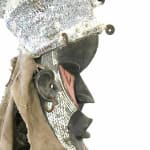Toma Wooden Polychrome Headdress with Feathers, 20th Century CE
Wood and Mixed Media
18 x 39
PF.4821
Further images
The Toma, known alternately as the Loma, are one of the numerous tribes of Mande-speaking people who descended from the northern savanna region into the forested band of west Africa...
The Toma, known alternately as the Loma, are one of the numerous tribes of Mande-speaking people who descended from the northern savanna region into the forested band of west Africa during the turbulent times of the later days of the Malian Empire (1230-1670). In recent times, the majority settled in the hilly rain forests of northern Liberia. Today, they number approximately two hundred thousand and are more or less equally divided between northern Liberia and southern Guinea (in Liberia, they are known as Loma while in Guinea the Mande form Toma is utilized). The Toma people practice shifting cultivation of upland rice that is suited to their high-altitude environment. They are patrilineal and their traditional political structures were based on village chiefdoms. The Toma are known for their long wooden masks that combine human and animal features. Nearly all masks were associated with the men’s society known as the Poro. This association was responsible for enforcing regulations regarding land use, initiation, marriage, and trade.
The largest type of Toma mask was over five feet tall with a long, movable, crocodile-toothed maul extending in front. The mid-section was composed of a human-like face with an exaggerated nose and forehead. The top section was crowned by a huge bunch of feathers of birds of prey stretching out at the back. For the Toma, as well as their neighbors the Bandi, this mask represented the major forest spirit (known as “Dandai” or “Landa”) that made manifest the power of the Poro. These masks were used during initiation ceremonies symbolically to devour boys in order to give them rebirth as men. While these huge masks are quite rare in collections, a relate type known as Nyangbai, representing the wife of the great forest spirit, are quite well known. These masks are smaller in dimension and feature a rounded forehead overhanging a large, flat facial plane. While some Toma masks were performed publicly, others, such as this type, would have only been seen by initiates. Toma masks are often striking for their stark simplicity of form, economy of line, and heavy sacrificial patina.
This mask, with its monumental tower of feathers, is an awesome sight. It is meant to be imposing, if not frightening, and to create in the viewer a feeling of something beyond this world. Such a mask would have surely been part of an initiation ceremony organized by the Poro society. Despite the fact that this mask lacks the extended maul described above, it seems likely that this mask functioned in the same way. When young boys reached the proper age, this great mask would have called them forth to leave their village and go on a month-long spiritual retreat into the bush. There, they are taught essential facts necessary in becoming a productive member of society. Upon completion, the initiation ended with the ritual devouring and symbolic rebirth. In this way, the mask served as a mediator between human beings and the spirits it was thought to embody. The striking pink around the eyes and white pigment used on the scarifications add dimension to the face. Fine slits for the eyes are an unusual feature, as is the angularity of the face itself. A bell attached to its middle and the thick iron earrings would have alerted everyone to the mask's approach.
The largest type of Toma mask was over five feet tall with a long, movable, crocodile-toothed maul extending in front. The mid-section was composed of a human-like face with an exaggerated nose and forehead. The top section was crowned by a huge bunch of feathers of birds of prey stretching out at the back. For the Toma, as well as their neighbors the Bandi, this mask represented the major forest spirit (known as “Dandai” or “Landa”) that made manifest the power of the Poro. These masks were used during initiation ceremonies symbolically to devour boys in order to give them rebirth as men. While these huge masks are quite rare in collections, a relate type known as Nyangbai, representing the wife of the great forest spirit, are quite well known. These masks are smaller in dimension and feature a rounded forehead overhanging a large, flat facial plane. While some Toma masks were performed publicly, others, such as this type, would have only been seen by initiates. Toma masks are often striking for their stark simplicity of form, economy of line, and heavy sacrificial patina.
This mask, with its monumental tower of feathers, is an awesome sight. It is meant to be imposing, if not frightening, and to create in the viewer a feeling of something beyond this world. Such a mask would have surely been part of an initiation ceremony organized by the Poro society. Despite the fact that this mask lacks the extended maul described above, it seems likely that this mask functioned in the same way. When young boys reached the proper age, this great mask would have called them forth to leave their village and go on a month-long spiritual retreat into the bush. There, they are taught essential facts necessary in becoming a productive member of society. Upon completion, the initiation ended with the ritual devouring and symbolic rebirth. In this way, the mask served as a mediator between human beings and the spirits it was thought to embody. The striking pink around the eyes and white pigment used on the scarifications add dimension to the face. Fine slits for the eyes are an unusual feature, as is the angularity of the face itself. A bell attached to its middle and the thick iron earrings would have alerted everyone to the mask's approach.





